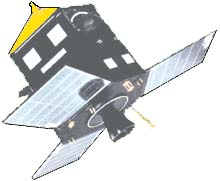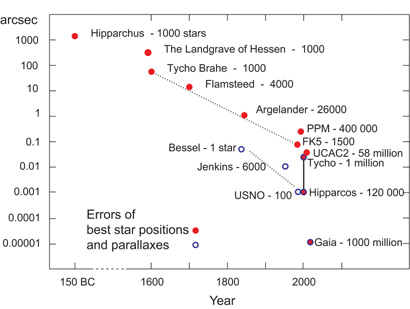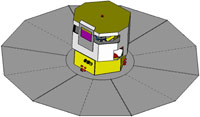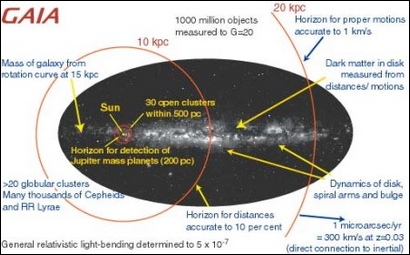Limits to Trigonometric Parallax
The main limitation with the use of trigonometric parallax is that the angles measured are always extremely small. Traditional ground-based optical observations also face the problems presented by observing through a turbulent atmosphere. These two factors combine so that the uncertainties in the measured values are very high for most stars. Until recently such ground-based methods were limited to a distance of about 40 pc. Only a small number of stars had reliable parallax measurements and thus reliable distances determined. As accurate distance measurements are vital in helping astronomers check models of stellar evolution, they are always after more accurate and precise distance values. One way to overcome the problems caused by the atmosphere is to get above it to observe. This means observing from space.
Space-based astrometry
In 1989, the European Space Agency launched the Hipparcos satellite (HIgh Precision PARallax COllecting Satellite) to measure the parallax and proper motions of stars. As it orbited the Earth above the effects of the atmosphere, it was able to measure parallaxes to an order of magnitude better precision than previous methods. The resultant Hipparcos catalogue gives positions, distances and proper motions for 118,218 stars to an average accuracy of 1 milliarcsecond (mas). It has helped astronomers refine their understanding of stars and calibrate the distance scale of the universe.
The Distance to Open Clusters
One key result was an accurate distance to the nearest open cluster, the Hyades, using measurements of parallax and proper motion. The plot below shows how the uncertainty in the distance to Hyades has changed over recent decades. Note the extremely small error bars for the Hipparcos determination, the one on the right.
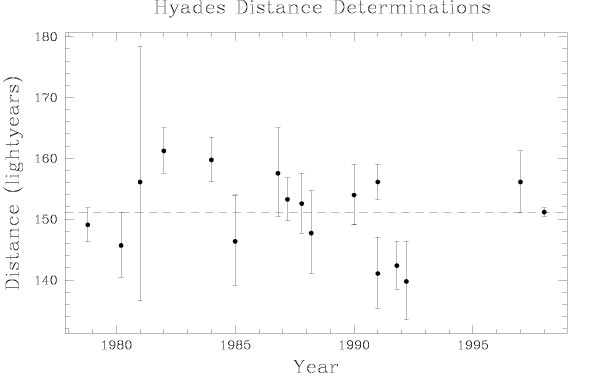
The distance to Hyades is a vital rung in what is commonly referred to as the Cosmic Distance ladder. Using Hipparcos data, astronomers have now calculated the distance to the centre of mass of the cluster to be 46.34 ± 0.27 pc. This new value allows the stars in the Hyades cluster to be fitted accurately on to an HR diagram and in turn, test models of stellar evolution. These suggest that the Hyades cluster is 625 million years old. Having an accurate HR diagram also allows the distance to other clusters to be determined using the main-sequence fitting technique even if they are too distant to have accurate parallax measurements made.
One other important finding from Hipparcos was a recalibration of the distance to another open cluster, the Pleiades. At 115 pc the new value is about 15% closer than previously thought, meaning that the cluster stars are actually dimmer than thought previously. This result has raised doubts about the standard main-sequence fitting models and suggests the need for more factors other than just metallicity to be considered. Debate still goes on among astronomers.
Future Missions
Hipparcos was launched over a decade ago and whilst its catalog has been a vital tool for astronomers, they are always keen for a larger database of accurate distances. New generation space-based astrometry missions are planned both by ESA and NASA.
The GAIA mission is planned by ESA for launch in 2010. It will obtain positions, distances and velocities for about 1 billion (1 000 million) stars, that is about 1% of the stars in the Milky Way with an accuracy of 10 microarcseconds. This will allow astronomers to construct a dynamic 3D map of our galaxy.
NASA are planning the Space Interferometry Mission, SIM, due for launch in 2009. Using the principle of interferometry it will measure parallaxes to 25 000 pc at a 10% accuracy level and stellar positions to within 4 microarcseconds.

